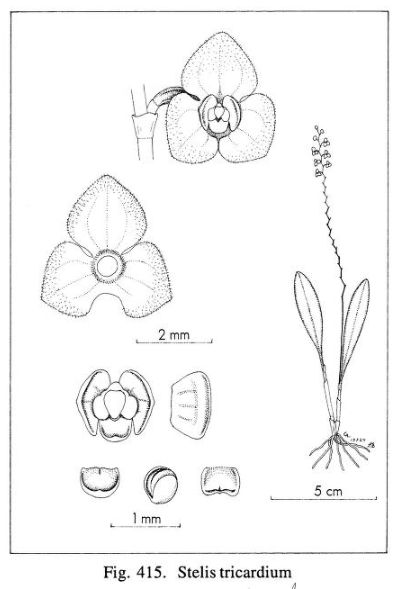

Stelis tricardium Lindl. 1859 SECTION Stelis
Drawing by © Carl Luer
Drawing by © Oscar Duque
Flower?? Similar to S cuencana and somewhat Duque's concept
Photo by © Patricia Harding
Flower?? in Ecuador Similar to Luer's Concept
Photo by © Marni Turkel


 LATE
LATE

Common Name The Three Hearts Stelis
Flower Size .16" [3.5 mm]
Found in Colombia?, Ecuador, Peru? and Bolivia? at elevations of 1500 to 2900 meters as a small sized, cool to cold growing, caespitose epiphyte with slender ramicauls enveloped completely by 2 to 3 tubular sheaths and carrying a single, apical, erect,coriaceous, oblong-cuneate to oblanceolate or spathulate, obtuse, long attenuate below into the channeled, petiolate base leaf that blooms in the late winter and spring on a suberect to diffuse, arising through a spathe from an annulus below the apex of the ramicaul, to 7" [17.5 cm] long includfing the 2 to 3.2” [5 to 8 cm] long peduncle, rather loosely many flowered inflorescence with tubular, obtuse, shorter than the ovary floral bracts and carrying glabrous externally, pubescent within, purple flowers [Luer] or pubscent flowers [Duque] that are dark red in the center, clear red at the margins.
CAUTION!!!!! A very confusing species. Lindley's original description is lacking in many details and so there are many concepts out there. I have included 2 here. Luer and Duque are miles apart in their determinations. Luer cites only Ecuador as provenence and only compares the species with S argentata and states that the flower is flat and widely expanded and the inflorescence is fractiflex with prominent floral bracts, Duque cites Colombia, Ecuador, Peru and Bolivia and compares the somewhat cupped flowers to both S platystacha a species with a flat rachis and S argentata which has a widely expanded flower. So use any of them with great caution.
This species, S cuencana and S piestopus are all said to be synomonous by many authors, with S tricardium taking precedence but Luer keeps them separate. Duque puts S piestopus as a symonym both say all three are related to S argentata.
Luer's concept: S argentata is common around Quito and a collection with shallowly connate, more or less cordate sepals, first thought to be a variation of S argentata, is presented here as S tricardium. A slender, flexuous raceme far surpasses the narrowly elliptical leaf. The sepals are pubescent, ovate, obtuse and more or less contracted below where they are connate only at the base. When expanded, they separate into three heart-shaped parts. The petals are broad with the margin narrowly thickened. The lip is small, not unlike the type "C" lip of S argentata but with a minute, obtuse apiculum." Luer 2009
Duque's concept; Compared to S platystacha, the 2 species are remarkable for their flattened peduncle and their long inflorescence which are out of proportion for the small vegetative parts of the plant.
According to Schlechter the citation by Kraenzlin corresponds to S cuencana.
What a mess!
Synonyms
References W3 Tropicos, Kew Monocot list , IPNI ;
* Fol. Orchid. 8: 14 Lindley 1859
Die Orchideen Schlechter 1915;
Orchids of Peru vol 1 Schweinfurth 1958;
First supplement to the Orchids of Peru Schweinfurth 1970;
Orchids of Bolivia Pleurothallidinae Vasquez & Ibisch 2000;
Icones Orchidacearum Peruviarum Plate 771 Bennett & Christenson 2001 drawing fide except inflorescence is not fractiflex;
Orchidaceae Stelis Swartz A Compendium Duque 2008 drawing not;
Icones Pleurothallidinarum Vol XXX Lepanthes of Jamaca Stelis of Ecuador Part IV Luer 2009
Icones Pleurothallidinarum Vol XXX Lepanthes of Jamaca Stelis of Ecuador Part IV Luer 2009 drawing hmm
--------------------------------------------------------------------------------------------------------------------------